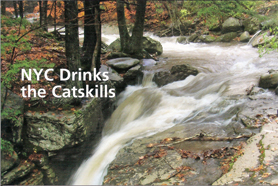National polls have shown that Americans put environmental matters close to the bottom of their list of concerns to be addressed by our political leadership, ranking much lower than the economy, medical care, or education of our children, but if there were greater awareness of the kind of stuff that was coming out of their taps, in their drinking water, they might rate environment near the top in importance, for it’s not too far a stretch to consider that stuff in their drinking water and relate it to the number of doctor visits, hospitalizations, or drugs they might need at some point in their lives. Lest they assume that they could replace their tap water with bottled water, they must realize that most bottled water does not originate in pristine springs, according to the impression conveyed by their labels and advertising, but comes from aquifers that are likely to be just as contaminated as their own, and add to that the toxics leaching into the liquid from the plastics.
Now, we must ask: are New York’s citizens speaking out to Governor Paterson in numbers enough to persuade him to pull the State out of a deal for a public-private partnership with a developer to establish a massive luxury resort that is completely out of character with its rural surroundings, to be located on a scenic Upstate mountain, where it would compromise the purity of the water in one of our reservoirs? Aren’t we on the losing side in that partnership?
New York City residents, for the last hundred sixty-seven years, have been blessed with some of the highest quality drinking water in the world. For that, we have relied on Upstate watersheds with forests, meadows, and wetlands that have performed the task of naturally filtering the groundwater that flows into our trout rich streams and then into our extensive reservoir system. In recent years, real estate overdevelopment in the Westchester and Putnam suburbs have been the rationale for a project to construct a chemical treatment/filtration plant in VanCortlandt Park for Croton Watershed water, now estimated to cost $2.85 million. In the case of those far Upstate areas, west of the Hudson River, in the Catskill and Delaware Watersheds, from where between 70 and 90% of the City’s water supply comes, through aqueducts that cross beneath the Hudson River, we have thus far managed to maintain a water quality that allows the City to repeatedly renew its exemption from a Federal EPA requirement to filter under the Clean Water Act, thus avoiding the hugely burdensome expense, now estimated at $20 to $30 billion, of constructing another water treatment/filtration plant.
The tap water in this area of Queens comes from those Upstate rural areas, which are lands of scenic, undeveloped mountains, unspoiled forest wildernesses, and clear trout streams which attract sports fishermen from all over the world. Dairy farms and other types of agriculture are prevalent. There are also state parks and recreation areas, summer camps, and small resorts and retreat centers that are visited by large numbers of tourists. Many City residents maintain second homes there as vacation getaways and they and the local people coexist in an organic network of small scale, environmentally sound communities. However some of the watershed communities are economically depressed, and area villages and hamlets are in need of revitalization.
Large tracts of rural and forest lands have been bought up by real estate speculators, some of it in the area known as Catskill State Park, a natural heritage preservation site. The Park includes the constitutionally protected Catskill State Forest Preserve. Also in the Park or adjacent to it, are the communities of Pine Hill, Shandaken, Fleischmanns, Arkville, and Hardenburgh, overlooked by Belleayre Mountain. This is about nine miles east of the Pepacton Reservoir, from which comes 25% of the New York City water supply. The waters of the streams and brooks below the mountain flow into the reservoir. Also located here is the State owned Belleayre Ski Center, operated by the Department of Environmental Conservation (DEC) and nearby are several tracts of forest land on which Crossroads-Ventures, LLC and General Partner Dean Gitter have for years been trying to get approval for the massive luxury resort project that they want to build. The latest version of this project, known as The Belleayre Resort at Catskill Park, proposed by Crossroads Ventures, envisions two luxury hotels, two underground spas, a conference center, parking facilities, maintenance and storage buildings, a total of 629 lodging units, an 18-hole golf course, a driving range, a clubhouse, five restaurants, 10 retail stores, all occupying a square mile of Belleayre Mountain, from the 3000 foot high summit to the base, with streetlights and miles of new connecting service roads. It would be the biggest town around, filled with transient residents.
Crossroads used a well-connected lobbyist to have then Governor Eliot Spitzer put together and sign, in a secret meeting that included some other entities, including several unsuspecting environmental organizations and New York City’s Department of Environmental Protection (DEP), an Agreement in Principle (AIP). Made public in September, 2007, this AIP would have the developer, Crossroads Ventures LLC (with partners Gitter, Pasternak, Fisher, etal) convey 1200 acres of forested slope to the State, to become part of the Catskill State Forest Preserve, on one side of the Belleayre Mountain, for a price exceeding the market price and eliminate one of the two originally proposed 18-hole golf courses. The AIP would reduce the acreage of the development by 15% (but not its density), and operate the golf course organically for a period of five years, with certain modifications and loopholes. The Crossroads people also agreed to eliminate their wastewater treatment plant from the plan in exchange for New York City DEP approval for their use of the heretofore underutilized, DEP financed Pine Hill Wastewater Treatment Plant.
The AIP is very lacking in precise numbers and contains legal loopholes that would allow the creation of environmental conditions which, once consummated, would bring irreversible harm to the waters flowing into the reservoir. While it includes a commitment by Crossroads not to build on “steep” mountain slopes, the AIP’s definition of “steep” is changed from the DEC recommended 15% incline to 20%. Since the area of allowable soil disturbance during the resort’s eight year construction period is not written into the agreement, the removal of trees and vegetation on the steep slopes and the blasting on the loose, shallow soil will allow stormwater, cascading down the mountain during the frequent heavy rainstorms, to bring with it much debris and sediment to the streams below only to flow on to the Pepacton Reservoir. This would be made much easier by the inherent conflict of interest written into the AIP which provides that the stormwater monitor would be hired and paid by the developer.
The functioning of the stormwater monitor would no longer be required once the project has been completed, and when the five year organic maintenance of the golf course expires, there would be nobody to even report on the washing of fertilizers, herbicides, and pesticides down the mountainside by stormwater.
The worst outrage of this agreement was the commitment of the State’s DEC to use $47 million in taxpayer money during these economically hard times, to upgrade the facilities of the Crossroads Ventures owned Highmount Ski Center with new ski lifts, ski runs, and snowmaking equipment, for the exclusive use of the resort’s well-heeled guests, giving them ski-in, ski-out convenience.
The AIP was a subversion of the legally prescribed procedure, under the State Environmental Quality Review Act (SEQRA). It was intended to give tentative DEC approval and win approval by the City’s DEP and certain environmental organizations even before Crossroads Ventures had submitted complete, precise numbers on these revisions of its pre-2007 plans, which had been vigorously opposed by the City’s DEP commissioner and had been criticized by others on many grounds before DEC’s own administrative law judge. By arranging and entering into this AIP with Crossroads-Ventures, Spitzer had compromised and undermined the DEC’s own permitting authority and the environmental groups that signed this agreement gave up their right to speak out publicly in opposition to it, and their right to seek adjudication on any issue that might come up after the filing of the final Supplementary Environmental Impact Statement as part of the SEQRA procedure.
This is only one of several threats to New York’s water supply and to its Upstate rural environment, and we need to use the strength of our numbers to let the Governor know that clean, affordable drinking water trumps economic growth in importance, and that we cannot allow this kind of twentieth century style development to force us to pay for another energy consuming, carbon producing water treatment plant, this time for the Catskill-Delaware waters, nor can we allow the government to trade away the purity of our water supply and the beauty of our mountain landscape for private profit. You can do this when you log on to www.savethemountain.net, if you have access to a computer, and click on “Sign the Petition”, and if you wish, you can add your own comment.
If you lack a computer or don’t have computer skills, you can send letters or postcards to the Governor and Commissioner Grannis of the Department of Environmental Conservation or you can call their offices and urge them to withdraw the State from the Agreement in Principle. Please note the addresses and phone numbers below.
His Excellency, Governor David A. Paterson
State Capitol
Albany, NY 12224
(518)474-8390
Hon. Alexander Grannis
Commissioner, Department of Environmental Conservation
625 Broadway
Albany, NY 12233-1011
(518)402-8545
“The human race will not survive unless we learn how to have jobs without growing in size.” – Signature of folksinger Pete Seeger on the “Save the Mountain” petition




